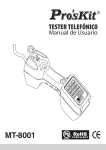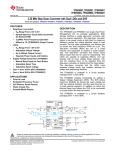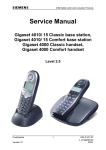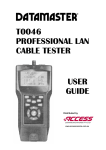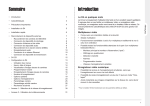Download TECHNICIANS TEST PHONE User's Manual
Transcript
TECHNICIANS TEST PHONE User’s Manual IP54 1st Edition © 2010 Access Communications Pty Ltd Technicians Test Phone User’s Manual Thank you for purchasing a Telemaster® Test Telephone. Before using it for the first time, please read the following instructions. Warning: The Telemaster® Test Telephone is designed for checking analog telecommunications lines and must not be connected to 240V mains power circuits as there will be possible electric shock or product damage. If you are uncertain of the voltage on the circuit you want to test, first set the test set to VDC mode and verify that the voltage is within a safe working range. Features 1. Complies with IP54 Dustproof & Waterproof tests 2. Drop Protection 3. Australian A-Tick compliance approval 4. High impedance monitoring 5. Circuit voltage-range LED indicators 6. Line Continuity test 7. Continuous polarity LED indicators 8. Speakerphone for convenient hands-free two-way conversation 9. Tone or pulse operation 10. Store up to twelve 16-digit speed-dial numbers plus an additional number store in the M1 button 11. Last number redial 12. PBX pause button 13. Mute switch 14. Electronic switch controls the volume of the speakerphone/monitor. 15. Automatic shut-off feature turns off speaker after five minutes of inactivity 16. Battery low-voltage LED indictors 17. Audible electronic ringer 18. Relocatable steel locking belt clip 19. Test clips and a 6P6C Modular plug are provided www.accesscomms.com.au 1 Technicians Test Phone User’s Manual Physical Characteristics 1. Speakerphone microphone 2. Keypad 3. Talk/Vdc/Monitor Switch 4. Battery Compartment (9V battery) 5. Fuse (in battery compartment) 6. Speakerphone/Monitor amplified speaker 7. Line cord strain relief 8. Optional Belt Hook location (2 places) 9. Handset receiver 10. Increase volume button 11. Handset/Speakerphone button 12. Reduce volume button 13. Handset Microphone 2 www.accesscomms.com.au Technicians Test Phone User’s Manual Keypad control and indicators: 1. 2. 3. RCL PPS/DTMF MUTE 4. VDC 5. CABLE 6. VDC(HI/LO) 7. 8. PSE STO 9. M1 10. LNR 11. 12. 13. 14. POL + POL LO BATT MUTE : Recall button. : Tone/Pulse switch. : Mute button. When pressing the mute button, the red mute LED will light : VDC button, check if the line is connected well and test, test the voltage of the outer-lead : Telecom line connecting-check LED, if the line is connected well, the LED lights up red : Voltage level LED indicator (please see the DC voltage-indication list) : PBX pause button : Store button is used for storing speed dialing numbers : Speed dialing button when the test set is on without press any other key : Last number redial button redials the number most recently dialed : Positive polarity LED indictor : Negative polarity LED indictor : Battery low-voltage LED : Mute LED to indicate if the mute function is on or not www.accesscomms.com.au 3 Technicians Test Phone User’s Manual Operation Talk/VDC/Monitor switch The test set has three basic modes of operation: Talk mode, off mode and Monitor mode. The T (talk) position gives an off hook condition for dialing and talking like a common analog telephone. The VDC position checks the voltage level of an incoming ring. The M (monitor) position removes the transmitter from the circuit and provides a high impedance coupling to allow line monitoring without disrupting conversations or signaling. There is no complete power off mode. The major function of "VDC" mode is for AC/DC power testing. The Mute LED will light up if the mute button is touched in the VDc mode and the battery will supply power to operate the LED until it is drained. Please make sure the Mute button is off before storing the unit to avoid unnecessary battery drain. Speaker and Speakerphone Microphone The speaker and speakerphone microphone are located on the keypad side of the test set. The speaker draws more current than any other circuit in the test set and the battery lasts longer if the speaker is used in moderation. Audio Controls Keys The control keys (VOL + / SPKR/ VOL -) are located on the inside handle of the test set between the handset receiver and the handset microphone. These controls let you switch between the handset and speakerphone. The SPKR button turns the test set speaker on and off. When the SPKR turns on the Speakerphone, this mode is intended for two-way, hands-free conversation. The VOL+ and VOL- keys control the active receiver’s sound level. 4 www.accesscomms.com.au Technicians Test Phone User’s Manual Tone/Pulse button The PPS/DTMF button works as a Tone/Pulse switch. Pressing this button toggles between Pulse and Tone modes. Storing Speed-Dial Numbers The STO button is used to store numbers in memory. There are 12 memory locations (keys 0 through 9, * and #), with each capable of storing up to 16 digits. To store a number: 1. Set the function button to “T” position. 2. Dial the number to be stored 3. Press STO button 4. Press the key for the desired memory location. Dialing using Recall key The RCL key is used to recall a number stored in memory. To dial the stored number 1. Set the function button to “T” position 2. After receiving dial-tone, press RCL button 3. Press the key for the memory location (keys 0 through 9, *and #) Dialing using the M1l key The M1 key stores one number using the same process above. If the function button is in the “T” position and M1 button is pressed, the stored number will be automatically dialed. Last Number Redial The LNR key redials the number most recently dialed. Pause There are some cases where it may be necessary to insert a pause between digits of a stored number, such as when accessing a trunk through a PBX that requires a digit 9 to access an exchange line. To store a number with a pause, simply press the PSE button at the point where the pause is required. The PSE button inserts a 4 second pause. www.accesscomms.com.au 5 Technicians Test Phone User’s Manual Operating the Test Set in Monitor Mode Set the function switch to “M” position and then press the SPKR button to open the monitor function. During monitoring please ensure the Line Continuity Test is not used to prevent crosstalk and low volume sound. To control the volume level, press VOL+ to increase volume and press VOL- for reduced volume. Mute function The mute button turns the handset microphone and speakerphone microphone off for privacy in Talk mode. Polarity Identification The polarity LEDs automatically illuminate to show line polarity. For example, the right red POL+ LED will light when you connect the red test lead to ring (positive) side of the line and the black test lead is connected to the tip (negative) side of the line. The left red POL- LED will light if the test leads are reversed. Line Continuity Test If you want to check that the line is correctly connected: 1. Connect the two sides of the telecom line to the test phone 2. Set the function switch to “VDC” position. 3. Press the VDC button. If the CABLE LED lights, it means the line is OK. If the CABLE LED does not light that means the line is not OK. Battery If the LO BATT LED lights, you need to change the battery to prevent data loss. To extend battery life, the speaker will automatically shut off after approximately five minutes if there has not been a signal greater than -30 dB in that period. Any signal greater than -30 dB resets the timer and keeps the speaker turned on 6 www.accesscomms.com.au Technicians Test Phone User’s Manual Line voltage test Outer-lead high voltage LED indication 1. Set the function switch to “VDC” position. 2. Connect the two outer-leads to the angled bed of nails. 3. Press VDC button to measure the voltage and indicate the LO/HI voltage level by different color of lights. If both LED not lights up, it means the tested voltage under DC24V. DC voltage-indication list LED(LO) LED(HI) Green Higher than 24V Red and Green Higher than 100V Green Higher than 150V Red and Green Higher than 200V Caution: 1. If the circuit voltage is greater than 250V or the function switch is not set to the “VDC” position; the fuse may blow. . www.accesscomms.com.au 7 Technicians Test Phone User’s Manual Trouble Shooting Defect Situation Possible Problem Solution Dead, Doesn’t work Blown fuse No tone Angled bed of nails are not well connected Speakerphone doesn’t work Short rings only Change fuse MUTE button was pressed and MUTE LED indicator lights up 1. Low battery 2. the angled bed of nails are connected to the power source Can not hear the conversations on the Monitor status 1. The switch is not set to “M” position 2. The SPKR button is off 3. Low battery Crosstalk 1. Angled bed of nails are not connected firmly 2. Interference from the line Memory of storing numbers doesn’t work Polarity LED doesn’t work CABLE LED doesn’t work LO HI(LED) doesn’t work BATT(LED) doesn’t work 8 Check if Angled bed of nails are well connected to telecom line Press the MUTE button and check if the MUTE LED is off 1. Change battery 2. Confirm if the angled bed of nails connected to the right telecom line 1. Set the switch to “M” position 2. Press the VOL+ button to increase volume 3. Change battery 1. Check if the Angled bed of nails are well connected 2. Press the VOL-button to reduce the interference Low battery Change battery Low battery Change battery Low battery Change battery Low battery Change battery Low battery Change battery www.accesscomms.com.au Technicians Test Phone User’s Manual Replacing the Battery If the test set fails to operate properly, or stops working, replace the battery and retest. A 9V alkaline battery must be installed for the test set to operate. Do not us rechargeable batteries. To replace the 9V battery: 1. Disconnect the test set from the line and place on a flat work surface with the battery cover facing up. 2. Use a Phillips screwdriver to remove the four screws from the battery compartment. 3. Remove the battery cover 4. Remove the old battery and properly discard. 5. Insert a new 9V battery into the test set and observe the proper polarity. 6. Place the battery cover back and fasten the four screws securely. Fuse replacement To replace the fuse: 1. Follow steps 1 to 3 above 2. Remove the battery 3. Remove the old fuse 4. Insert a same specification (ø5xL20mm, 250mA/250V) fuse 5. Place the battery and battery cover back, then fasten the four screws securely. Caution After the battery is removed, the stored number memory will retain stored information for 10 seconds only. Maintenance 1. Disconnect the test telephone from any circuit before performing any maintenance. 2. Do not use chlorinated solvents on the test set www.accesscomms.com.au 9 Technicians Test Phone User’s Manual Specifications ELECTRICAL Loop limit 2 KΩ maximum at 48 VDCdc (nominal 20mA minimum loop current) DC resistance Talk Mode 300Ω typical Monitor impedance 39kΩ nominal at 1 KHz Rotary dial output Pulsing rate 10pps+0.8pps Percent break 61%±2% Interdigit interval 1000 ms typical Leakage during Break >50 KΩ DTMF output Tone frequency error ±1.2% maximum Tone level -8±2dBm combined (typical) High versus low tone Difference 4 dB maximum Memory dialing Memory capacity 13 memories including M1, last number redialing Digit capacity 16 digits per memory PBX pause duration Line Voltage Test Monitor amplifier power 4 seconds 5 Phase AC/DC voltage indication(under24 V、 24~100V、101~150V、151~200V、more than 200V) 9V transistor; provides 25 hours continuous use, source typical Automatic power shut off After 5 min. of no audio signal Speaker phone levels Electronic adjustable Power source battery (9V) 6F22 (not included) PHYSICAL Measurement Weight Water Resistance Cord Sets 230 ×82 × 89mm (9-1/16” × 3-15/64” × 3-1/2”) 635g typical Complied with IEC/EN 60529 IP54 Dustproof & Waterproof tests Angled bed of nails and RJ11 plug ENVIRONMENTAL Temperature Operating:0 to 50°C / Storage:-10 to 60°C Altitude To 10,000 feet (3,000M) max Relative humidity 5 To 95% CERTIFICATE IP54, CE approved 10 www.accesscomms.com.au Technicians Test Phone User’s Manual www.accesscomms.com.au 11













